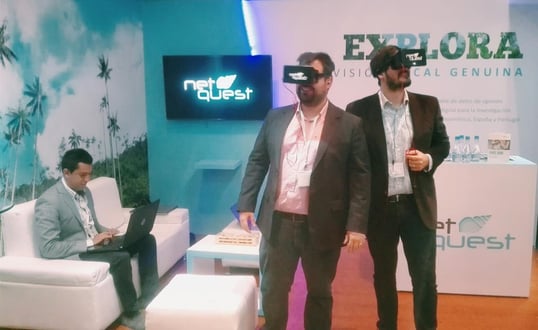When you think of doing research to understand Advertising Effectiveness what’s the first thing that comes to your mind? Maybe conducting a Survey? Think again.

Considering the increasing number of touchpoints with brands, Ad Effectiveness Research cannot be measured only with declared data (surveys) and even cookie technologies are not enough right now. It’s time to think outside the box. Trying different technologies, types of data and even combining them can help brands gain efficiency, improve ROI and make decisions to prove effectiveness on Ad spend. Find out more about 5 data technologies you can use today to improve your Advertising Effectiveness studies:
1. An all-time digital classic: the Cookie-based data.
Exposure to Display Advertising using 3rd party cookies (or your own)
What’s the recipe for the perfect digital cookie? A desktop browser, a snippet of code and a user. But this recipe is not new. For years the use of Cookies has helped advertisers, media agencies and brands to identify users to Ad Networks and sites.
First-party cookies are dropped by the publisher or website owner when a user visits their own site. But there are also third-party cookies that are used for Ad retargeting and Behavioral advertising. In this cases, an advertiser adds a tag to a page, and this way it can track a user or their device across different websites.
One of the downsides in the use of Cookies is that they are set by websites, publishers or ad networks, each maintaining their own cookie. This requires a costly and inefficient practice of “cookie syncing” to move data from one company to another.
2. The Mobile Ad ID.
Measure Ad campaigns in app
The Mobile Ad ID is a code that’s set by the OS and is considered PII because it is unique. It is similar to cookies because it allows to identify who has been exposed to an Ad in App (like the Facebook app) but it is different in a way that it’s not set by the website or publisher and there’s no need to sync data from one app to another.
This information can be matched with the advertiser previously created Ad Ids database to see if people have been exposed to the campaign and what has been the impact on the audience. But in order to do that, it is necessary to explicitly ask users to share this data (their ID)
Since this PII is sensitive data, we need to be careful with its use and ensure its privacy. People’s privacy and GDPR must be guaranteed in any case. We, at Netquest, follow different processes to make sure that this basic principle it’s never broken.
3. The Google maps of Ad Effectiveness: Geolocation data.
Discover where the target audience has been exposed to an Ad: at home, in a restaurant, in the office, or using public transport, etc.
Have you ever wondered how in the world did people used to travel before Google Maps? That’s kind of the same question we ask ourselves about Brands that don’t use Geolocation Data nowadays to measure the impact of Out-of-Home Advertising spaces.
Imagine your client hired a brilliant agency to run a campaign and to buy some of the main billboards in a city to launch its new product, like the one done by Ogilvy Paris for IBM in 2013.
Besides all the awards this creative campaign won at Cannes-Lions, imagine that your client needs to prove it actually bought the right space for it:

Wouldn’t Ogilvy want to know how many people actually “passed” by these billboards and if they were the right target? And in this case if they served their purpose?

4. Digital Behavior with Clickstream Data: the user-centric measurement.
Find out: did the campaign change the online behavior of the target audience?
Unlike cookies (which are site-centric) digital behavior data is based on the user and it can be defined as the set of actions that people do in their digital life that can be observed through a collection of clickstream data (URLs)
Digital Behavioral data is every action we perform in our digital life when we visit a website, do an online search, make a purchase, go to social media or use an app, etc.
Gerald Zaltman, professor at Harvard Business School, said in his classic textbook How Customers Think: “the correlation between stated intent and actual behavior is usually low and negative.” Usually, people don’t really remember everything they do online and thanks to the collection of clickstream there are ways to understand changes in behavior caused by Advertising.
For example, the Brand for weight loss called Golo uses Behavioral Data to understand the impact of their TV Ads. They’ve seen that much of the search traffic is triggered by people that see an Ad on TV and since they know that 20% - 25% of people conduct online searches before becoming a customer, Golo has started to work to get a better understanding of the dynamic between its TV Ads Effectiveness and search-driven traffic.
5. It’s a Match! The tinder of Ad Effectiveness: Audio-matching data.
A unique way to measure the audience exposed to an Ad on TV, radio and/or even Internet videos.
Audio-matching is a truly innovative technology that collects “ambient” sounds from panelists devices and then matches it with a previously created database of Ads (that is made up of audios from TV, radio and even the Internet).
The way it works is: a unique code is created for each Ad or specific content, like a fingerprint. Then, all those codes are uploaded into a database. When the panelist listens to an Ad that was in that database, the technology detects it and recognizes this specific code and we can say: It’s a Match!
For us, it has been love at first "sound" with Audio-matching. We’ve seen amazing results when used correctly -like what RTVE did in Spain to measure the content consumption of its hit TV show: Operación Triunfo . As you might guess this methodology can be applied to an Ad campaign as well.
---
So now you know a little more about the data and technologies you have at your disposal to improve your Ad Effectiveness Research. But of course, you can also rely on the good all survey and ask about recalls and opinions before and after advertising exposure to measure effectiveness.
All these sources of data can be combined but for that, you’ll need the right partner to help you out… ask your panel provider if they can deliver one of these, or all of above, from the same individual for a powerful Ad Effectiveness Research.
Here at Netquest we’re eager to help you out!






